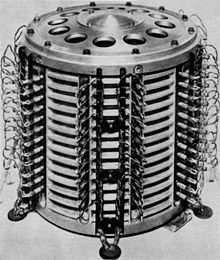Drum memory

| Computer memory and Computer data storage types |
|---|
| Volatile |
| Non-volatile |
Drum memory is a magnetic data storage device and was a early form of computer memory widely used in the 1950s and into the 1960s, invented by Gustav Tauschek in 1932 in Austria. For many machines, a drum formed the main working memory of the machine, with data and programs being loaded on to or off the drum using media such as paper tape or punch cards. Drums were so commonly used for the main working memory that the machines were often referred to as drum machines. Drums were later replaced as the main working memory by memory such as core memory and a variety of other systems which were faster as they had no moving parts, and which lasted until semiconductor memory entered the scene.
A drum is a large metal cylinder that is coated on the outside surface with a ferromagnetic recording material. It is, simply put, a hard disk platter in the form of a drum rather than a flat disk. A row of read-write heads runs along the long axis of the drum, one for each track.
The drums of the Atanasoff–Berry Computer stored information using regenerative capacitor memory.
A difference between a drum as described and a modern disk is that on a drum the heads do not have to move to the track to access; the controller simply waits for the data to appear under the relevant head as the drum turns. In a disk drive the head takes a certain time, the seek time, to move into place, while the performance of a drum with fixed heads is determined almost entirely by the rotational speed. This advantage is not inherent to drum technology; in principle a drum with a single moving head could be made, and fixed-head disks with one head for each track were commonplace in the 1960s.
Access time was determined by the time taken by the drum to rotate wanted data into position, and in the worst case was the time for a full revolution. Particularly while drum were used as main working memory, programmers often took to positioning code onto the drum in such a way as to reduce the amount of time needed to find the next instruction. They did this by timing how long it would take after loading an instruction for the computer to be ready to read the next one, then placing that instruction on the drum so that it would arrive under a head just in time. This method of timing compensation is called the Skip Factor or interleave, and was used for many years in hard disk controllers.
In modern-day BSD Unix and its descendants, /dev/drum is the name of the default swap device, deriving from the use of drum secondary-storage devices as backing store for pages in virtual memory.
External links
- The Story of Mel – the classic story about one programmer's drum machine hand-coding antics
- Librascope LGP-30 – The drum memory computer referenced in the above story, also referenced on Librascope LGP-30.
- Librascope RPC-4000 – Another drum memory computer referenced in the above story
